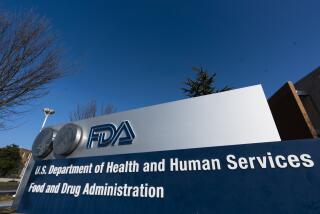Study Suggests Genes Might Affect Breast Cancer Drug’s Efficacy
- Share via
Reducing the risk of recurrent breast cancer in women treated for the disease or keeping the cancer at bay in those who are predisposed have been issues facing doctors for decades.
Tamoxifen, prescribed for more than 20 years as a medication to reduce the risk of the disease, is a reliable choice for doctors treating breast cancer patients. And, as a major study three years ago showed, the drug works well stopping cancer before it starts in women at high risk. Just who qualifies for tamoxifen seemed to be called into question in recent weeks in a relatively small study, reported in the Journal of the American Medical Assn., on the drug’s effectiveness in preventing cancer.
Looking only at the 288 of 13,000 women who developed breast cancer in the Breast Cancer Prevention Trial, in which participants received either tamoxifen or a placebo, researchers drew more conclusions, particularly about those with a genetic predisposition to breast cancer. Of those women with mutations in the so-called breast cancer genes, BRCA1 and BRCA2, scientists found that women with BRCA2 were more likely to be protected by tamoxifen than carriers of BRCA1. Among the 288 women who developed breast cancer, eight had BRCA1; five of those had received tamoxifen and three received placebos. Eleven of the patients had BRCA2, of whom three had used tamoxifen and eight received placebos.
The study, which has raised questions among oncologists and patient advocates, now is being put into perspective by members of the team that conducted it. “We’re only talking about prevention here. This [study] had nothing to do with the treatment of breast cancer,” said Dr. Lawrence Wickerham, a breast cancer researcher with the National Surgical Adjuvant Breast and Bowel Project in Pittsburgh. The analysis was conducted in collaboration with geneticist Mary-Claire King of the University of Washington in Seattle.
“My biggest problem is that these results are far from being statistically significant,” said Dr. Lora Weiselberg, chief of the breast service in the division of medical oncology at North Shore University Hospital in Manhasset. “These results could have occurred by chance. These are very small numbers and you cannot say they’re etched in stone.”
Tamoxifen works by blocking the estrogen receptors on breast cancer cells, thus preventing the potent hormone estrogen from latching onto those sites. That action by tamoxifen is highly beneficial because it prevents estrogen, a growth promoter, from fueling the cancer’s proliferation.
Doctors know early on in a patient’s care whether she is vulnerable to estrogen-driven tumor growth by conducting a hormone-receptor test during diagnosis. When results come back ER+, or estrogen-receptor positive, that means a hormone-blocking drug, such as tamoxifen, can be used. When the test comes back ER-, or estrogen-receptor negative, then tamoxifen and medications like it would prove useless. Tamoxifen, sold as Novaldex by AstraZeneca Pharmaceuticals LP, belongs to the class of drugs known as SERMs, or selective estrogen-receptor modulators. SERMs can act as an anti-estrogen, as tamoxifen does in the breast, or they can act like estrogen, as tamoxifen does in the bones, liver and uterus.
Tamoxifen’s estrogen-like activity is beneficial in the skeletal system where it functions to maintain bone strength, and in the liver where it weakly helps to lower the bad form of cholesterol, but is problematic in the uterus. There, some women older than 50 run a higher risk of uterine cancer because the drug acts like estrogen and can drive cancer growth. Weiselberg said that even though the journal article reported that BRCA1 patients are less likely to benefit from tamoxifen because they are more likely to be ER-, that notion has been around for years.
However, just because someone has a BRCA1 mutation, Weiselberg added, that does not mean she is automatically ER-. Hence, the importance of hormone-receptor testing. Mutations in the two genes, BRCA1 and BRCA2, account for less than 10% of all cases of breast cancer, studies show.
Wickerham acknowledged that medical researchers have much further to go before they learn all there is to know about BRCA1 and BRCA2.
“We’ve known about these two genes for less than a decade. We are really in the infancy of understanding them.” There may even be mutations in BRCA1 that cause patients to be ER+, he said. Patient advocate Barbara Brenner is executive director of Breast Cancer Action, an activist group in San Francisco that has lobbied vociferously against tamoxifen being marketed as a way to “prevent” breast cancer because tamoxifen also carries an increased risk of uterine cancer. She said the study contained flaws.
“Proponents are heralding a 62% decrease in breast cancer risk for women with BRCA2 mutations. That sounds big, but it’s misleading,” Brenner said. “People need to understand that the actual difference between the two arms of the study was minuscule.” How widely tamoxifen should be prescribed remains an unresolved question. But studies are being conducted globally on new SERMs that carry fewer side effects than tamoxifen and drugs like it.






